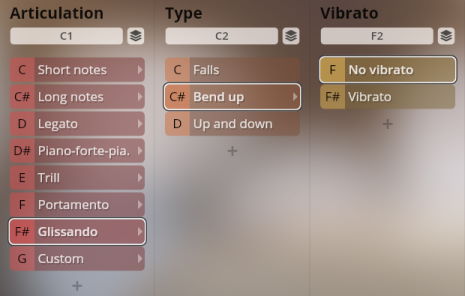SYNCHRON-ized Whistler
Introduction
Welcome to the Vienna Symphonic Library’s series of Synchron Instruments! SYNCHRON-ized Vienna Whistler is based on its Vienna Instruments namesake, and offers a completely overhauled sample database optimized for the Vienna Synchron Player. Our goal was to improve each instrument’s playability and realism even more, which we achieved by enhancing the sample recordings as well as by utilizing the Synchron Player’s unique features.
About Preset
Synchron libraries generally offer different Presets according to how velocity is handled, arranged in separate folders.
“VelXF sus - MOD”: velocity crossfading is only activated for long notes, while the dynamics of short notes are controlled by keystroke velocity, thus facilitating phrasing.
“VelXF - MOD”: all articulations have velocity crossfading activated so that you can control dynamics with MIDI controller CC1, the modwheel.
“Velocity”: note volume is controlled by keystroke velocity just like a piano. Apart from that, velocity crossfading can always be enabled or disabled by clicking its on/off symbol in the Synchron Player's Perform tab.
Presets are subdivided into different articulation categories, including one named “Custom” and ready for your own creations. Within these articulation categories, you can select a type, e.g., normal or marcato, and for some of the types there are additional options available, such as normal/marcato crossfading. If you happen to be short of RAM, you can deactivate Articulations you do not need, and activate them again if necessary.
Switching between playing styles and articulations is generally done via dedicated keys on the keyboard and aptly called “keyswitches”. By default the keyswitches for Articulations are mapped starting from C1. Type keyswitches normally start from G1.
Dimension Controllers offer additional options within some Articulations or Types, most notably that of crossfading between different Patches. The controller function is indicated by the group’s respective caption, as of course it may take on different tasks as needed.
About Patches
Patches can be used to build your own custom Presets and adapt the Synchron Libraries to your specific requirements. For further information on constructing Presets, please see the Synchron Player manual.
Mixer Presets
For each instrument, there are a number of Mixer Presets that depict different recording situations. The basic Mixer Presets are Close, Classic, Distant, short and long Reverb without convolution, and MIR unprocessed; others (e.g., different positioning in the hall) may be added according to voice.
About Pitch
For designating pitch, the Vienna Symphonic Library uses International Pitch Notation (IPN), which was agreed upon internationally under the auspices of the Acoustical Society of America. In this system the international standard of A=440 Hz is called A4 and middle C is C4. All pitches are written as capital letters, their respective octave being indicated by a number next to it. The lowest C on the piano is C1 (the A below that is A0), etc.
The Synchron Player software allows you to set middle C to C3, C4, or C5 according to your preference. Selecting another setting than C4 will of course also change the play ranges and keyswitches accordingly.
Included Presets
The Vienna Whistler is Marcus Schmidinger, whose name VSL users might be already familiar with, as he performed on all of the horn instruments included in our Brass I and Brass II Collections – both as a soloist (of the Viennese horn and the triple horn) as well as a member of the Horn ensemble on the popular Epic Horns.
During the recordings it turned out that Marcus is not only a true horn virtuoso, but also an excellent whistler with an incredibly homogeneous timbre over a wide key range of approximately two octaves.
Historically, so-called “art whistlers” echo an Austrian tradition of the 19th century when they would perform in Viennese community theatres, vaudeville shows and cabarets.
Vienna Whistler offers short notes, long notes, legato, piano-forte-piano, trills, portamento, and glissando articulations.
- Range: E4–G6; trills E4–C6.
- Articulation keyswitches: C1–G1.
Short notes
Staccato, short portato, medium portato with vibrato, legato repetitions, and long portato with normal and strong vibrato.
- Type keyswitches: C2–E2.
Staccato, Portato short
Repetitions/single notes: F2/F#2.
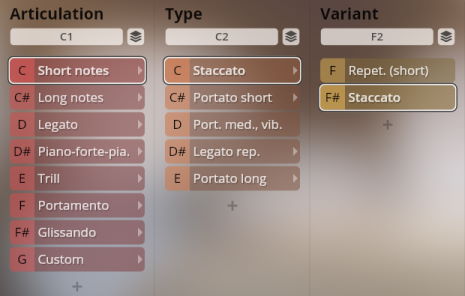
Legato repetitions
Legato repetitions without and with vibrato, and a crossfading option. Use Dim.Ctrl/C (MIDI CC20) for vibrato crossfading.
- Vibrato keyswitches: F2/G2.
- Vibrato crossfading: Dim.Ctrl/C (MIDI CC20)
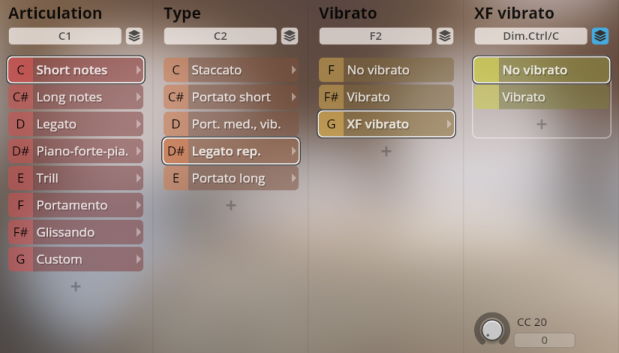
Portato long
Long portato with normal and strong vibrato. For consistency with the no vibrato/vibrato options of other slots, the keyswitches begin with F#2 for normal vibrato.
- Vibrato keyswitches: F#2/G2.
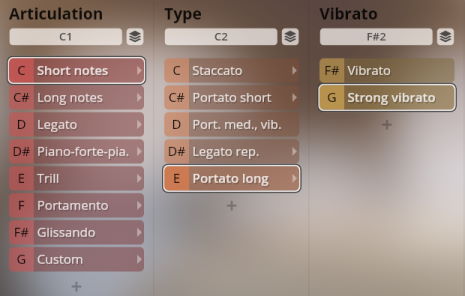
Long notes, Legato
Long notes normal and marcato without and with vibrato, legato normal and fast without and with vibrato, each with normal and fall release. With the vibrato crossfading option, use Dim.Ctrl/C (MIDI CC20) to control crossfading.
- Normal/marcato, normal/fast: C2/C#2.
- Vibrato keyswitches: F2–G2.
- Vibrato crossfading: Dim.Ctrl/C (MIDI CC 20).
- Normal/fall release: C3/C#3.
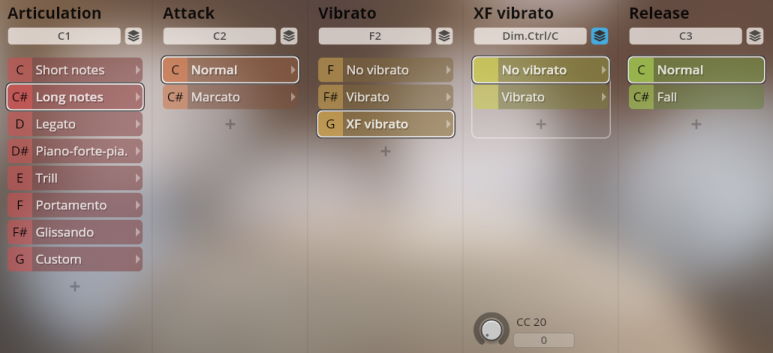
Piano-forte-piano
- Piano-forte-piano 2/4/6 seconds.
- Length switches: C2–D2.
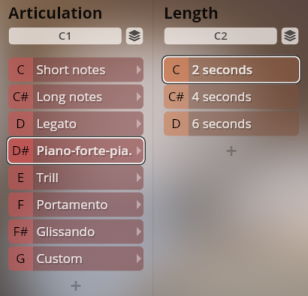
Trills
Half and whole tone trills with normal and fall release.
- Half/whole tone switch: C2/C#2.
- Normal/fall release: C3/C#3.
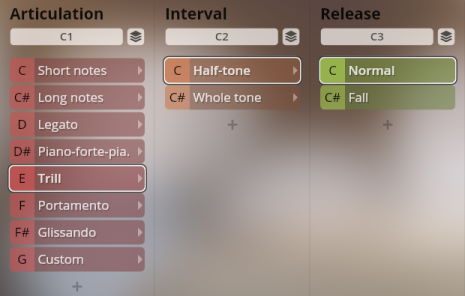
Portamento
Slow and fast portamento without and with vibrato, as well as normal and fall release. ustained and performance clusters. With the vibrato crossfading option, use Dim.Ctrl/C (MIDI CC20) to control crossfading.
- Slow/fast portamento: C2/C#2.
- Vibrato keyswitches: F2–G2.
- Vibrato crossfading: Dim.Ctrl/C (MIDI CC 20).
- Normal/fall release: C3/C#3.
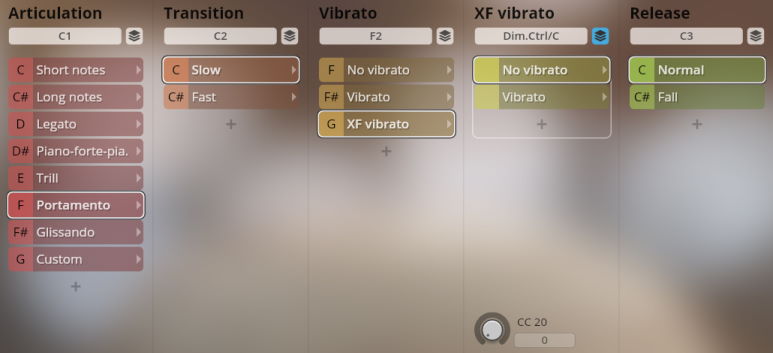
Glissando
Falls, bends up without and with vibrato, and up and down glissandos.
- Falls/bends/up-down: C2–D2.
- Bends no vibrato/vibrato: F2/F#2.
